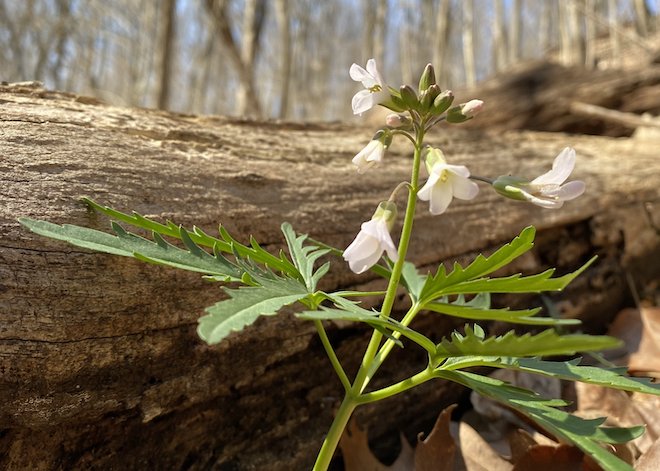Cutleaf Tooth-what?
Cutleaf Toothwort grows alongside a log at Frick Park in Pittsburgh, PA.
Finally, flowers! This week, I noticed Virginia Bluebells and Cutleaf Toothwort (Cardamine concatenata) blooming in the park. Although Cutleaf Toothwort is new to me, it is native to most of the U.S. east of the Rocky Mountains.
This delicate woodland ephemeral blooms for only about a month and stays small—under 12 inches—making it quite easy to overlook! It has pinkish-white bell-shaped flowers and deeply lobed and toothed leaves. Fun fact: “toothwort” doesn’t refer to its leaves but to tooth-like bumps on its rhizome.
A Critical Larval Host Plant
Due to its early flowering, toothworts are an important food source for early-emerging beneficial insects. Moreover, toothworts are the only larval host plants for West Virginia White butterflies.
Unfortunately, West Virginia Whites are in decline due to the usual suspects: habitat fragmentation, deer over-browsing, and one invasive plant in particular: Garlic Mustard (Alliaria petiolata). Cutleaf Toothwort and Garlic Mustard are in the same family, Brassicaceae, and West Virginia Whites confuse the two plants. If a West Virginia White deposits her eggs on Garlic Mustard, the newly hatched caterpillars will be poisoned and do not survive. Another good reason to remove Garlic Mustard wherever you see it!
A Little History
And now for some ethnobotany: historically, Iroquois used Cutleaf Toothwort medicinally. But its uses weren’t limited to illness: it was also used as a love medicine (put some in your pocket to attract the ladies) and a hunting medicine (put some on your weapon or fishing hook to attract dinner).
Growing Cutleaf Toothwort at Home
Has this tempted you to grow Cutleaf Toothwort in your garden? Unfortunately, while seeds are commercially available, they do not store well, and if plants sprout, they may take three to four years to bloom. While more easily propagated by rhizome, they should not be collected from the wild. Instead, purchase bare root or already growing plants from a reputable native plant grower.
Managing Garlic Mustard
Garlic Mustard in bloom. Pull it!
Like many invasive plants, Garlic Mustard was intentionally brought to the U.S. from Europe for culinary use. Unfortunately, our area has the perfect conditions for it to thrive, and each plant can produce thousands of seeds that can survive without sprouting for as long as five years. To pile on, it is thought to release allelopathic compounds that inhibit other plants from growing in the soil. Of course, deer don’t like the flavor of this plant, so their browsing ways are no help.
However, there’s something you can do! Obviously, you should pull this weed on your own property. But why stop there? If you see Garlic Mustard in untended places, pull it and toss it in the trash. If there is no trash nearby, and it has yet to flower, you can still pull it out of the ground, fold it over to prevent it from re-establishing and leave it along the walk. I’ll admit to pulling this invasive in the park and from my neighbors’ ignored “behind the fence” areas. It’s a good deed! (That’s my story for the judge, anyway.)


